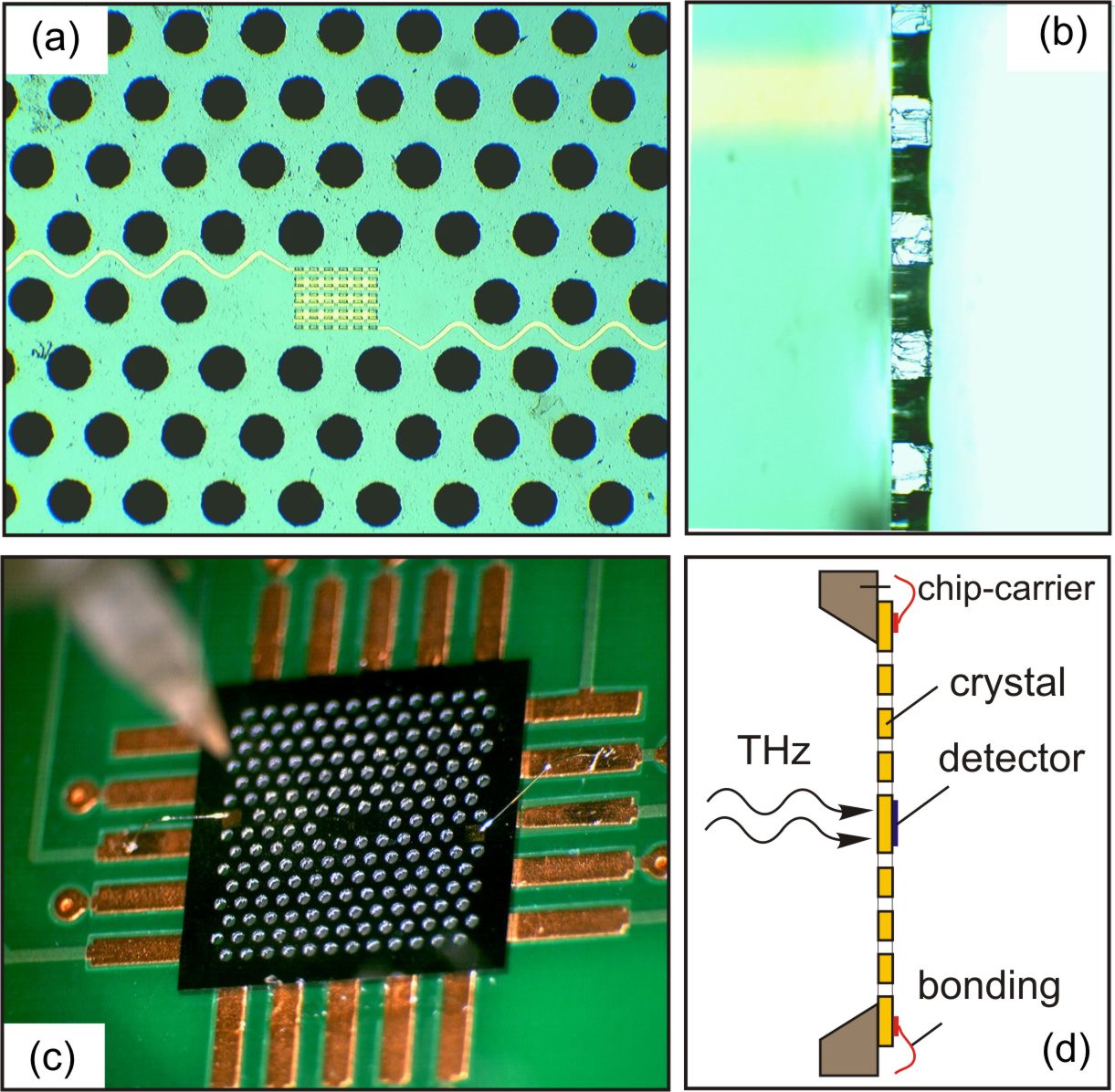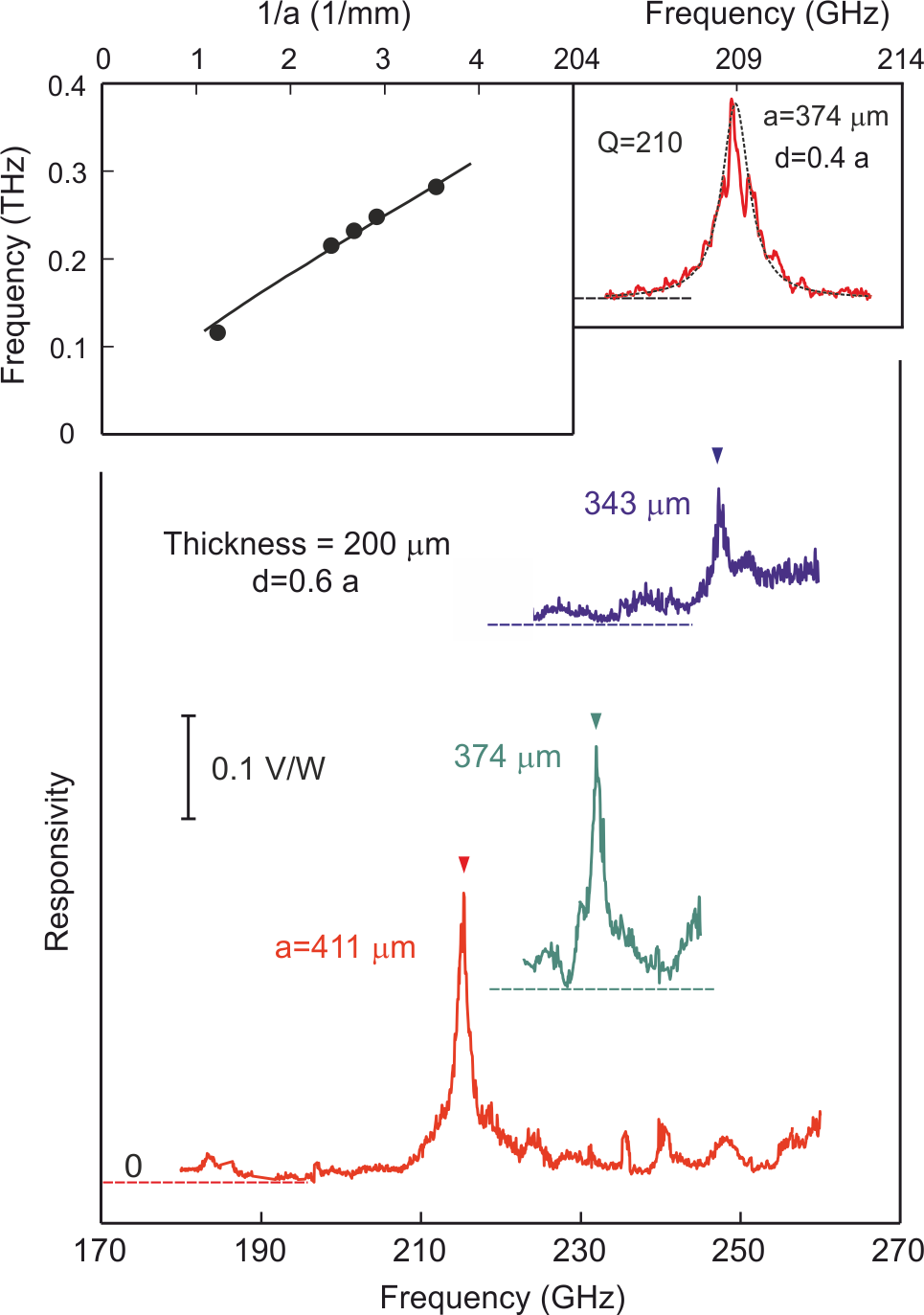A solid-state spectrometer consisting of an array of broadband plasmonic detectors, each of them embedded in a microcavity of a photonic crystal (PC), has been developed in the Laboratory of Non-equilibrium Electronic Processes ISSP RAS. The microcavity of PC provides frequency selectivity while a plasmonic detector converts radiation at a selected frequency into a measurable photovoltage or photocurrent signal. This device can be used in various areas of science and technology: molecular spectroscopy, space research, biology, medical tomography, high-frequency wireless communication systems.

In recent years there has been a surge of research activity in the field of sub-terahertz and terahertz radiation (100 GHz to 3 THz). Such interest is caused by unique properties of terahertz range, which allow a variety of potential applications. However, its spectral location between optical and microwave frequencies hinders development of compact terahertz generators and terahertz spectroscopy systems. This leads to an increased demand for components that can be used to manipulate THz radiation on-chip. However, in comparison with electrons in media, it is difficult to confine or store light and to control its speed. Photonic crystals are expected to solve the problems by allowing one to manipulate the behavior of light in media beyond the conventional limitations. However, at present photonics is not versatile enough, and many standard electronic functions such as memory and logic cannot be achieved by THz photonics alone. For this reason, research on hybrid photonic crystal–electronic structures is of great importance.
Early experiments on THz photonic crystals were primarily focused on defect-free structures. Their main objective was to investigate properties of periodic media. The terahertz frequency range was chosen due to the ease of fabrication of the experimental samples. However, it is clear that, as for optical frequencies, the principal advantage of THz photonic crystals rest on the incorporation of defects to disturb their periodicity and thereby introduce localized cavity photon modes. The first terahertz experiments on photonic crystals with embedded defects have demonstrated the existence of high-Q photon cavity modes. Research on hybrid electronic devices with embedded photonic crystals was pioneered in the works on electrically pumped photonic-crystal THz quantum cascade lasers. The application of PC technology has enabled simultaneous spectral and spatial laser mode engineering.

For trial experiments photonic crystals slab (PCS) with embedded plasmon detectors was fabricated from a single GaAs wafer with 2D electron layer in the GaAs/AlGaAs heterojunction in a unified lithographic process. A two-dimensional electron layer is necessary for the plasmonic detector fabrication. The electron density of the two-dimensional electrons and electron mobility at room temperature were 6×1011 cm-2 and 6000 cm2/V∙s respectively. The thickness of photonic crystal slab was 200 μm. Periodically situated through-wafer holes, forming the photonic crystals, were fabricated in the slab by plasma etching. We investigated PCSs with triangular lattice constants a = 247, 292, 343, 374, 411, 544, and 816 μm. The diameter of holes was d = 0.6a, total sample size 6 × 6 mm2 (Fig. 1). Microresonator was fabricated as a row of three absent holes in the PC center (Fig. 1). The broadband detector was located in the center of the microcavity.
Figure 2 shows a schematic diagram of a microwave and terahertz radiation spectrometer based on photonic crystals. The spectrometer includes an array of photonic crystals (1) with microcavities (2). One or more broadband plasmonic detectors (3) connected to the periphery of the spectrometer crystal (5) via metallic interconnects (4) are embedded into each microcavity (2). The signal of photovoltage / photocurrent from the detectors (3) through signal lines (4) reaches signal conversion unit (6), where it is multiplexed, amplified and digitized. Thus, the signal is converted into a format compatible with computer interfaces. Then it goes to the computer (7).
The operation principle is based on the frequency selectivity of the microcavities. The electromagnetic radiation (8) under investigation irradiates the crystal of the spectrometer (5). Each of the photonic crystals (1) with the microcavity (2) provides selectivity at certain frequency f. Thus, only the spectral component f of the radiation is resonantly amplified in the microcavity (2). Its power is measured by a plasmonic detector (3) located in a microcavity (2). A matrix of N detectors placed in microcavities of photonic crystals, each tuned to its own resonant frequency fi (i = 1,2 ... N), detects powers of the spectral components fi of the radiation being studied. This technique does realize the spectroscopy of electromagnetic radiation (8).
Figure 3 shows photoresponse of the terahertz detectors in PC microcavities with lattice constants a = 411 μm, 374 μm, and 343 μm versus incident monochromatic microwave radiation frequency. Each of the three experimental curves demonstrate a sharp resonance peak, which position (marked by arrows) shifts with PCS period a. The left inset of Fig. 3 shows resonance frequency as a function of the inverse lattice constant. Dots correspond to the experimental data, while the solid line represents theoretical simulations. There is a good agreement between the calculations and the experiment, and both shows that the period of the photonic crystal determines the spectral component fi of the analyzed radiation, which is detected by the receiver. The right inset of Fig. 3 shows detector photoresponse as a function of incident radiation frequency for a PCS with lattice constant a = 374 μm and diameter of through holes d = 0.4a, i.e., smaller than in the main figure. The experiment shows that the resonance frequency undergoes red shift compared to the case of a d = 0.6a PC slab. Decrease of hole diameter results in increase of microcavity size, and in turn in reduction of resonance frequency from f = 231 GHz to 209 GHz. There also shown a Lorentzian fit of the resonance (dashed line) from which the quality factor of the resonance Q was determined. For this photonic crystal, a record frequency selectivity Δf = 1.0 GHz was obtained (Q = 210).






